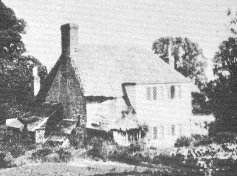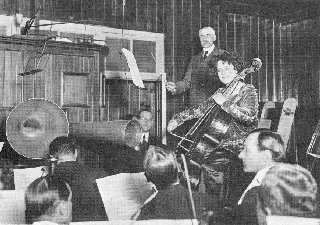|
Most of Elgar's music was written between 1890 and 1914, part of the flowering of European
art that preceded the Great War. The Enigma
Variations, Gerontius and the two
symphonies belong to the same world as the poetry of Yeats and Rilke, the plays of Galsworthy
and Shaw, the music of Strauss and Puccini. All of these artists created new works after 1914,
but the world they came from, and which had nourished them, was gone.
The scale of the war was apocalyptic, and, before it happened, few people had thought such
destruction were even possible. In Britain, for example, the public's notion of modern warfare had
been formed by the Boer War, in which 22,000 British troops had died over a period
of two-and-a-half years. In this new conflict, nearly that many British soldiers were
killed on a single day: July 1, 1916, the first day of the Battle of the Somme. Over the course of
four years, more than 900,000 people from Britain and the Empire countries lost their lives - not
only men, but women, too, serving as nurses. Submarines and long-range artillery made no
exceptions on grounds of gender. Even as the conflict raged, many people recognized that they
were now living in a changed society. Writing in 1916, D.H. Lawrence felt that two thousand
years of civilisation were collapsing before his eyes: "so much beauty and pathos of old things
passing away and no new things coming: my God, it breaks my soul."
These were the circumstances when Edward Elgar checked into a London nursing home in
March of 1918 to have his tonsils removed. Surgery on a sixty-year-old man was considered
somewhat dangerous, but his doctors decided it was necessary. "He was in a great deal of pain
for several days," the composer's daughter Carice wrote later. "There was not anything like the
sedatives we have now, but nevertheless, he woke up one morning and asked for pencil and paper
and wrote down the opening theme of the Cello Concerto." In the weeks to come, however,
Elgar made no attempt to put this new melody in 9/8 time to use. Appalled and disillusioned by
the war, he had done little sustained composition since 1914, except for The Spirit of England, a setting of three wartime poems by
Laurence Binyon. "I cannot do any real work with the awful shadow over us," Elgar wrote to his
friend, art historian Sir Sidney Colvin.
 |
| Brinkwells
|
|
In May, Elgar, his wife Alice and Carice went to live at Brinkwells, the thatched cottage in
Sussex where the family had spent the previous summer. It was just north of the village
of Fittleworth, near what is now the A283, with a view of the Arun River and the
South Downs. Having been born in the small Worcestershire village of Broadheath,
Elgar loved the countryside, and the rural surroundings helped ease his recovery. The
springtime woods were carpeted with bluebells, and finches sang in the hedges. Yet
even in leafy Sussex, the war made its presence felt: at night the family heard artillery
rumbling across the Channel. As Summer came, Elgar took pleasure in watching local farmers
at work and in doing some woodworking himself. He now tried orchestrating the melody in 9/8
time he had written in March but still had no clear idea of how he might use it.
Then, in August, Elgar surprised his family by announcing that he wanted one of his pianos,
an old Steinway upright, taken from storage and installed at Brinkwells. The day after the
piano arrived, Elgar set to work on a sonata for violin and
piano, and Alice noticed at once that it was different from anything he had written
before. She called it "wood magic ... so delicate and elusive." Elgar completed the sonata within
weeks, and during the next five months he developed this new style further in a piano quintet and a string
quartet. In Adrian Boult's words, "a new note of fantasy, of freedom and of economy"
had come into Elgar's music. All three chamber works were premièred in May of 1919,
by which time Elgar had gotten the idea of using the 9/8 melody in a concerto for cello
and orchestra.
The sketches for the work have unfortunately been lost, but we can
trace some of its development through letters and diaries. On 2 June, Elgar's
sixty-second birthday, conductor Landon Ronald paid a visit to Brinkwells, and Elgar
played him long passages from the concerto on the piano. Three days later Felix
Salmond, who had played at the première of the chamber works, came to try out the
work on the cello. "FS most delighted and enthusiastic," Alice noted in her diary.
Elgar continued his efforts with an intensity he had not known for years. Many mornings that
summer he was up at 4 or 5 in the morning, scoring the work and adding new
passages. In late July he told Sidney Colvin that he had "nearly completed a Concerto
for Violoncello: a real large work and I think good and alive." He planned to dedicate
it to Colvin and his wife Frances. The composer would conduct the first performance
himself, and he asked Salmond to be the soloist. Salmond returned to Sussex to try out
some final additions, and on 8 August Alice brought the completed score to
Fittleworth Post Office and mailed it off to London. The work ran about half an hour,
the length of a Hadyn symphony. Like the chamber works, it was spare and
concentrated, but the themes of the concerto were more memorable and its musical
argument cut deeper. It was a work "haunted by an autumnal sadness," in Diana
McVeagh's words, "but the sadness of compassion, not pessimism."
The concerto had its première on 27 October with the London Symphony Orchestra
at Queen's Hall. Rehearsal time had been inadequate, and the review by Ernest Newman, a
leading critic, began by complaining about the ragged performance. He went on to say: "The
work itself is lovely stuff, very simple - that pregnant simplicity that has come upon Elgar's music
in the last couple of years, but with a profound wisdom and beauty underlying its
simplicity ... a fine spirit's lifelong wistful brooding upon the loveliness of
earth."
 |
Elgar conducting the 1919
recording of the
concerto
|
|
There's an interesting footnote to that first performance. One of the players that
evening was a promising, nineteen-year-old musician named John Barbirolli. Some
sixty-six years later, his recording of the work with Jacqueline du
Pré and a later London Symphony would be hailed by many as its definitive
interpretation. The Cello Concerto has become a favourite with audiences, and it was a favorite
of Elgar's, too. He recorded it twice: in 1919 and again in 1928. During his final illness in 1933,
Elgar hummed the concerto's first theme to a friend and said, "If ever after I'm dead you hear
someone whistling this tune on the Malvern Hills, don't be alarmed. It's only me."
|